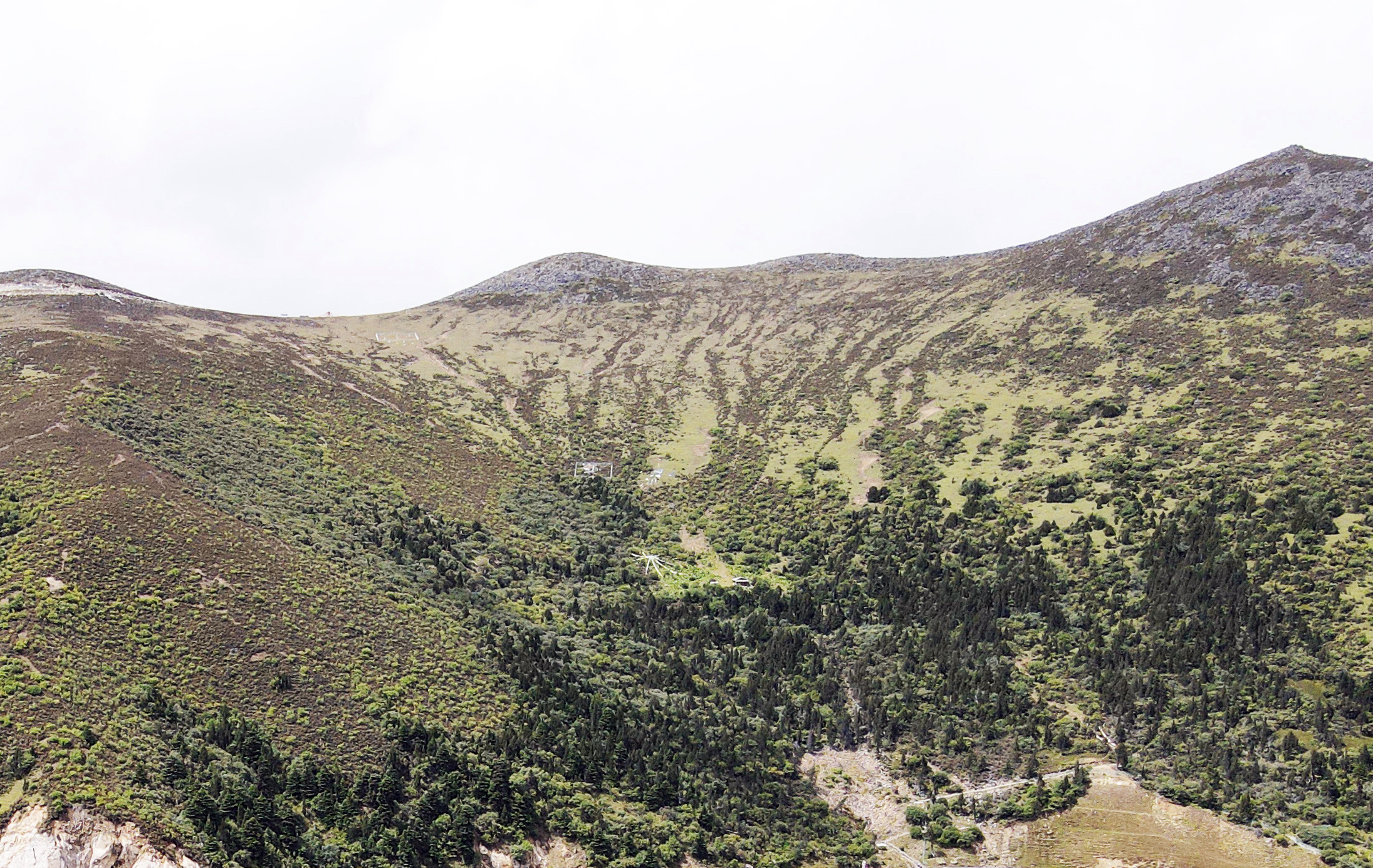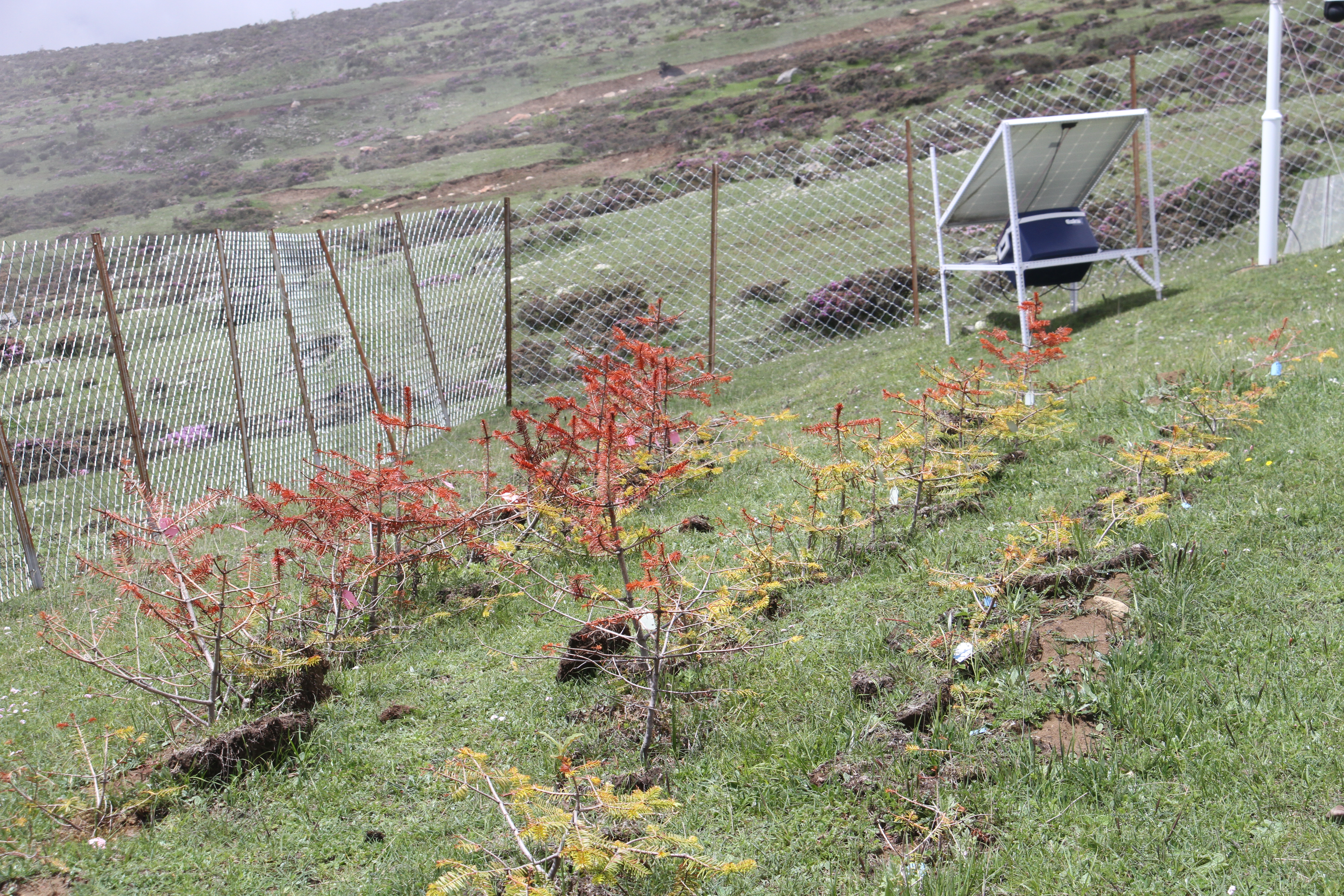-
In this post, Wensheng Chen, a Master's student from the Tibet Agricultural and Animal Husbandry University, discusses and shares his published paper in Journal of Plant Ecology in 2024, “Facilitation drives tree seedling survival at alpine treelines”.
Why study the Alpine Treelines?
In the Sygera Mountains of the southeastern edge of the Qinghai-Tibetan Plateau, it lies an alpine treeline ecotone soaring above 4300 meters—a true “climate-sensitive zone.” Here, each seedling of Abies georgei var. smithii fights to survive amid bitter cold, intense solar radiation, and relentless winds. Our journey into this rugged landscape began with a puzzling question: As global warming, alpine treelines are expected to climb upward—yet their shift lags far behind the rate of climate warming. What invisible force is holding them back?
 Alpine Treeline Ecotone of Sygera Mountains
Alpine Treeline Ecotone of Sygera MountainsWhile most previous studies pointed to temperature as the key driver for treeline shift, we wondered if something else was at play. In this extreme environment—a natural laboratory of survival—could interactions among plants be the missing piece? Over years of fieldwork in southeastern Tibet, we noticed something telling: seedlings sheltered under Rhododendron aganniphum shrubs or tree canopies were consistently healthier and survived far better than those exposed in open meadows. This repeated sight sparked a hypothesis: perhaps interspecific and intraspecific facilitation was offering a kind of “ecological umbrella,” shielding young trees from harsh conditions. Maybe the secret lay in how canopies tempered solar radiation and created milder microclimates.

Transplanted seedlings of Abies georgei var. smithii
To test the hypothesis, we designed a transplant experiment. We brought 720 carefully selected Abies georgei var. smithii seedlings—from three age classes (4–6, 7–9, and 10–15 years old)—up to the treeline ecotone in May 2021. Each seedling was transported with its root ball intact to avoid transplant shock. With no roads leading to our sites between 4300 and 4500 meters, everything—seedlings, pots, and equipment—had to be carried up by hand. We established plots in three distinct microhabitats: under canopies (“canopy-in”), at canopy edges (“canopy-out”), and in open meadows, ensuring the setup was as controlled and precise as possible.
What are the findings of this study?
What followed was three years of patience and persistence. The non-growing season on the Sygera Mountains is harsh and long; from November to May, deep snow blankets the landscape, and temperatures often plunge below –15°C. Each spring, as soon as the snow began to melt, we’d climb back up, often digging through lingering snowdrifts to check on each seedling. Finding seedlings withered by frost was always a sobering moment—every loss mattered for the integrity of our data. Maintaining our weather stations was another challenge. Under the intense high-elevation solar radiation, equipment aged quickly. We made quarterly trips to inspect and recalibrate sensors, ensuring continuous records of temperature, humidity, and radiation. At one point, we realized that our weather instruments were positioned 1.5 meters high—far above the seedlings, which stood less than 50 cm tall. It was a small but meaningful lesson: in high-altitude ecology, the finest scales matter, and we must measure conditions where life actually unfolds.
Two findings, in particular, stood out. First, the power of facilitation was much stronger than we expected. Seedling mortality reached 57.8% in open meadows, but under Rhododendron aganniphum shrubs, it dropped to just 18.87%. These canopies didn’t just block radiation—they boosted humidity, and even slow wind speed. Surprisingly, Rhododendron aganniphum offered better protection than Abies georgei var. smithii or Juniperus saltuaria. Their low, dense structure created a uniquely sheltered microhabitat, making us reconsider the role of shrubs in treeline advancement.
The second revelation was hidden in the leaves. We used to think low temperatures alone limited seedling growth at high elevations. But leaf trait analysis revealed a nuanced survival strategy: seedlings increased starch content, reduced soluble sugars, developed smaller leaves, and raised specific leaf area (SLA)—all signs of a “conservative” resource strategy. They were saving energy, not spending it. Structural equation modeling (SEM) further showed that solar radiation indirectly shaped leaf morphology by altering seasonal moisture and temperature conditions, which in turn influenced survival. Notably, intense radiation during the non-growing season induced freeze-thaw stress and photoinhibition—proving more damaging than summer conditions. It became clear: focusing only on growing-season temperatures means overlooking how winter stressors filter out the vulnerable.
Throughout this study, we kept reflecting: alpine treelines are not just climate change indicators—they are profound classrooms in plant adaptation. While warming may create opportunities for treelines to ascend, it is biological interactions that decide which seedlings seize that chance. Moving forward, predicting treeline shifts will require more than temperature models. We must also account for the nurse trees and shrubs that offer shelter. They are the silent facilitators of upward migration—and the unsung guardians of alpine ecosystem stability.
Some views on ecological research
Today, the seedlings on the Sygera Mountains continue their slow, steadfast growth. Our observation over them goes on. Perhaps in time, we will see them become young trees, embodying the slow but persistent march of the treeline under the dual influence of facilitation and a changing climate. That hope is what drives us to keep working at these high elevations—to decode nature’s subtle scripts through scientific data, and in doing so, contribute to the understanding and protection of Earth’s fragile alpine ecosystems.
About the author

Wensheng Chen
During my Master’s degree at Tibet Agricultural and Animal Husbandry University, I investigated the ecological processes of the alpine treeline on Sygera Mountain in southeastern Tibet under the supervision of Professor Jiangrong Li. This work laid a solid foundation for my future research. The experimental design and manuscript preparation received meticulous guidance and assistance from Professor Liang Eryuan from the Institute of Tibetan Plateau Research, Chinese Academy of Sciences. And Professor Jesús Julio Camarero from the Instituto Pirenaico de Ecología (IPE-CSIC), Zaragoza, Spain.
After obtaining my degree in May 2023, I joined Professor Enrong Yan’s team at the School of Ecological and Environmental Sciences, East China Normal University, to pursue my Ph.D. I have since broadened my research scope from mountain ecology to islands, with a primary focus on island biogeography and the role of plant diversity in maintaining ecosystem stability.
CiteScore: 5.7
Yuanhe Yang
Bernhard Schmid
ISSN 1752-9921(print)
ISSN 1752-993X(online)





